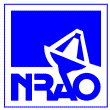
National Radio Astronomy Observatory
P.O. Box O
Socorro, NM 87801
http://www.nrao.edu
March 7, 2007
Contact:
Dave Finley, Public Information Officer
Socorro, NM
(505) 835-7302
dfinley@nrao.edu
The Atacama Large Millimeter/submillimeter Array (ALMA), an international telescope project, reached a major milestone on March 2, when two ALMA prototype antennas were first linked together as an integrated system to observe an astronomical object.
The milestone achievement, technically termed "First Fringes," came at the ALMA Test Facility (ATF) on the grounds of the National Radio Astronomy Observatory's (NRAO) Very Large Array (VLA) radio telescope in New Mexico. NRAO is a facility of the National Science Foundation (NSF), managed by Associated Universities, Incorporated (AUI). AUI also is designated by NSF as the North American Executive for ALMA.
Faint radio waves emitted by the planet Saturn were collected by the two ALMA antennas, then processed by new, state-of-the-art electronics to turn the two antennas into a single, high-resolution telescope system, called an interferometer.
Such pairs of antennas are the basic building blocks of multi-antenna imaging systems such as ALMA and the VLA. In such a system, each antenna is combined electronically with every other antenna to form a multitude of pairs. Each pair contributes unique information that is used to build a highly-detailed image of the astronomical object under observation. When completed in 2012, ALMA will have 66 antennas.
The successful Saturn observation began at 7:13 p.m., U.S. Mountain Time Friday (0213 UTC Saturday). The planet's radio emissions at a frequency of 104 GigaHertz (GHz) were tracked by the ALMA system for more than an hour.
"Our congratulations go to the dedicated team of scientists, engineers and technicians who produced this groundbreaking achievement for ALMA. Much hard work and many long hours went into this effort, and we appreciate it all. This team should be very proud today," said NRAO Director Fred K.Y. Lo. "With this milestone behind us, we now can proceed with increased confidence toward completing ALMA," he added.
ALMA, now under construction at an elevation of 16,500 feet in the Atacama Desert of northern Chile, will provide astronomers with the world's most advanced tool for exploring the Universe at millimeter and submillimeter wavelengths. ALMA will detect fainter objects and be able to produce much higher-quality images at these wavelengths than any previous telescope system. Scientists are eager to use this transformational capability to study the first stars and galaxies that formed in the early Universe, to learn long-sought details about how stars are formed, and will trace the motion of gas and dust as it whirls toward the surface of newly-formed stars and planets.
"This was fantastic work. Using our two prototype antennas to observe Saturn was the first complete, end-to-end test of the advanced systems we are building for ALMA," said Adrian Russell, North American Project Manager for ALMA. "ALMA is an extraordinary international endeavor, and the collaboration of partners from around the world is vital to the success of the project," Russell added.
"The success of this test is fundamental proof that the hardware and software now under development for ALMA will work to produce a truly revolutionary astronomical tool," said Massimo Tarenghi, Director of the Joint ALMA Office.
"This achievement results from the integration of many state-of-the- art components from Europe and North America and bodes well for the success of ALMA in Chile," said Catherine Cesarsky, ESO's Director General.
In addition to the leading-edge electronic and electro-optical hardware and custom software that proved itself by producing ALMA's first fringes, the system's antennas are among the most advanced in the world. The stringent requirements for the antennas included extremely precise reflecting surfaces, highly accurate ability to point at desired locations in the sky, and the ability to operate reliably in the harsh, high-altitude environment of the ALMA site.
The ALMA Test Facility includes prototype antennas built by VertexRSI in the U.S. and by the AEC Consortium (ALCATEL Space of France and European Industrial Engineering of Italy). These antennas were evaluated individually at the ATF. Both prototypes were fitted with electronic equipment for receiving, digitizing and transmitting signals back to a central facility. At the ATF, a small-scale prototype version of ALMA's giant central, special-purpose computer, called a correlator, has been installed. The correlator combines the signals to make the antennas work together as a single astronomical instrument. The full-scale ALMA correlator is being built at the National Radio Astronomy Observatory's Technology Center in Charlottesville, Virginia, and will be installed at the high-altitude site in Chile when completed. ALMA also will include Japanese antennas built by Mitsubishi.
ALMA is an international astronomy facility. It is a partnership of Europe, Japan, and North America in cooperation with the Republic of Chile. ALMA is funded in Europe by the European Southern Observatory (ESO), in Japan by the National Institutes of Natural Sciences (NINS) in cooperation with the Academia Sinica in Taiwan, and in North America by the U.S. National Science Foundation (NSF) in cooperation with the National Research Council of Canada (NRC). ALMA construction and operations are led on behalf of Europe by ESO, on behalf of Japan by the National Astronomical Observatory of Japan (NAOJ) and on behalf of North America by the National Radio Astronomy Observatory (NRAO), which is managed by Associated Universities, Inc. (AUI).